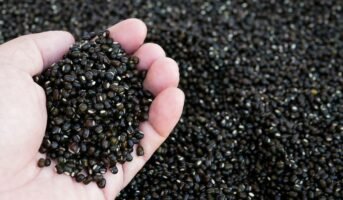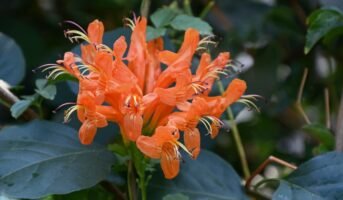The Snowball bush, a prominent genus within the flowering shrub category, contains various distinct varieties. This collective term denotes a range of snowball bush plants, with Snowball Viburnum standing out as a notable example. This flowering bush exhibits collections of small flowers, presenting an aesthetically attractive ball-like arrangement. Its adaptability extends to suitability for cultivation in both subtropical and temperate regions.
See also: How to grow and care for Boston ivy?
Snowball Flower plant: Key facts
| Botanical name | Viburnum x carlcephalum |
| Common name | Snowball bush viburnum, fragrant snowball, European cranberrybush |
| Family | Adoxaceae |
| Native area | Europe |
| Plant size | 6–12 ft. tall, 6–10 ft. wide |
| Sun exposure | Full, Partial Exposure |
| Soil type | Well- Drained |
| Soil pH | Neutral |
| Flower colour | White, light pink |
| Toxic | Non-Toxic (unripe berries of this plant can exhibit some amount of toxicity) |
Snowball flower: Types
- Cayuga viburnum – The Cayuga viburnum, is a crossbreed from V. carlesii (Korean spice viburnum) and V. x carlcephalum, and boasts a more compact size, standing 4 to 10 feet tall and wide. In the spring season, it bursts into profuse bloom, covered with impressive 4-inch clusters of white flowers.
- Judd viburnum – The Judd viburnum (Viburnum x juddii), is a captivating hybrid derived from V. carlesii and V. bitchiunse. This shrub stands resilient against leaf spot infections and proves more suitable for breeding.
- European Snowball Bush – The European Snowball Bush, scientifically termed Viburnum opulus ‘Roseum,’ also recognized as European cranberrybush or European viburnum snowball bush gives a flower in spring, and the size of the flower is up to 3 inches. These flowers first bloom as an apple-green color then after maturing change to white.
- Japanese snowball bush – The Japanese Snowball Bush, a member of the viburnum family, first blooms during the spring. These flowers, measuring 2-3 inches in diameter change color from white to a delicate pink as they mature.
- Chinese snowball bush – The Chinese Snowball Bush, scientifically classified as Viburnum macrocephalum, boasts some of the most substantial snowball flowers, with flower heads stretching up to an impressive 8 inches in diameter. The flowers of this plant shift color from a pale green hue to a creamy shade and eventually into a pure white color showing a tricolor effect.
- Fragrant Snowball bush – Fragrant Snowball Bush, officially known as Viburnum carlcephalum, not only delights with its visual appeal but also fragrant the surroundings in a sweet perfume. Each flower globe, measuring an impressive 5 inches across, comprises up to a hundred individual blossoms.
How to grow snowball flower?
Here are the steps for growing this plant at home.
- Begin by eliminating any grass or weeds from the designated planting site, and make sure that the place is fully clean.
- Create a hole in the soil that is both shallow and expansively broad. The dimensions of the hole should be three times the diameter of the root ball, yet maintain a depth that is not more than the root ball itself.
- With care, extract the snowball bush from its container. Use your hands to delicately release any outer roots sticking to the sides and bottom and be careful during this process, avoiding any harm or fracturing of the bush’s vital roots.
- Position the bush at the hole’s center, ensuring the root crown sits approximately 1.5 to 2 inches above the encircling ground level.
- Refill the cavity with soil, restoring the ground to its natural state around the newly positioned snowball bush.
- Immediately after planting, well water the area to thoroughly saturate the soil and help to settle the soil.
- Extend a layer of mulch or wood chips, maintaining a depth of around 4 inches, over the entire planting region. This not only aids in moisture retention but also acts as a deterrent against weed expansion.
Snowball flower: Care tips
- Light – Optimal placement for a snowball bush viburnum typically involves exposure to full sunlight, especially in the cooler northern regions. This shrub lives with a daily dose of at least six hours of sunshine, ensuring the development of substantial clusters of flowers.
- Soil – The snowball bush exhibits a preference for well-drained, loamy soil, yet it proves adaptable, and flourishing in various soil types. While it can take a broad range of soil pH levels, it leans towards a preference for relatively acidic soil conditions.
- Water – Maintain a consistently moist environment for the snowball bush as it doesn’t like dry soil. A recommended watering of the bush involves supplying approximately 1 inch of water per week, though adjustments may be necessary during periods of intense heat.
- Temperature and humidity – The plant can live in both dry and humid conditions if there is effective air circulation and proper soil drainage.
- Fertilizer – Feed the plant during the spring season with a slow-release fertilizer or incorporate compost into the surrounding soil at any time also be alert for not adding excess fertilizer as excessive nitrogen can cause the plant’s growing potential.
Snowball flower: Common problems and pests
Similar to many plants, there might be circumstances when you need to handle potential disease issues or pest invasions with this bush. However, there are preventative steps you can take. It is advisable to maintain some distance between the snowball bush and other plants to minimize the risk of bacterial leaf spots or powdery mildew. Another common issue for the snowball bush is aphids. If there are any tiny pests seen on the leaves, consider using an organic insecticide like neem oil for a thorough spray. Viburnums are notably prone to bacterial leaf spot diseases, and managing the situation becomes challenging once the disease takes hold. Plants severely affected by this issue often require to be removed.
Snowball flower: Toxicity
The unripe berries can be a little toxic and can cause diarrhea but mature berries don’t have any kind of toxicity.
FAQs
How to properly care for a snowball bush?
These plants can tolerate partial shade, they truly like to grow under full sunlight for at least six hours each day during their growing season. To maximize the potential growth of the snowball bush viburnum, it's crucial to plant them where there is plenty of sun.
What steps should be taken to cultivate a snowball plant?
Begin by burrowing a broad and shallow hole, assuring its depth matches the root ball while being two to three times wider. Fill this hole with the displaced soil, keeping the root crown approximately 2 inches above the soil level to adequately water the newly planted bush, and surround it with a layer of mulch about 4 inches deep.
Where is the optimal spot to plant a snowball bush?
These bushes grow when exposed to six to eight hours of direct sunlight. It is essential to place them in an area with moist, humus-rich, and moderately alkaline soil that drains effectively.
What fertilizer is recommended for snowball bushes?
Snowball bush by administering a water-soluble, general-purpose fertilizer every two months from spring to fall. An alternative is to use a well-balanced blend, such as 10-10-10, sticking to the instructions on the label.
Can a snowball tree be propagated from a cutting?
An alternative method to grow a snowball tree involves growing new plants from cuttings taken from the stems of a mature snowball tree, or the parent plant. To determine if a branch has reached the ideal softwood stage, try to bend it, if the branch bends and subsequently breaks into two pieces, it means it is in the softwood stage.
What might be the cause if a snowball bush is wilting?
If the wilting occurs during the daytime heat but recovers in the evening, it likely experiences moisture sufficiency and is merely undergoing heat stress. On the other hand, persistent morning wilting indicates a need for water, or the plant may be waterlogged.
How tall can a snowball tree grow?How tall can a snowball tree grow?
The Snowball Tree, also known as the Guelder-Rose, is cultivated for its striking ball-shaped flowers and red berries. It can stain a height of 3m.
| Got any questions or point of view on our article? We would love to hear from you. Write to our Editor-in-Chief Jhumur Ghosh at jhumur.ghosh1@housing.com |
Anil Shah, is your go-to source for property market insights. He excels at understanding and explaining the latest trends in residential real estate and making complex real estate concepts easier to grasp. Anil’s fact-based analysis helps buyers and investors make sound decisions in the housing sector.












